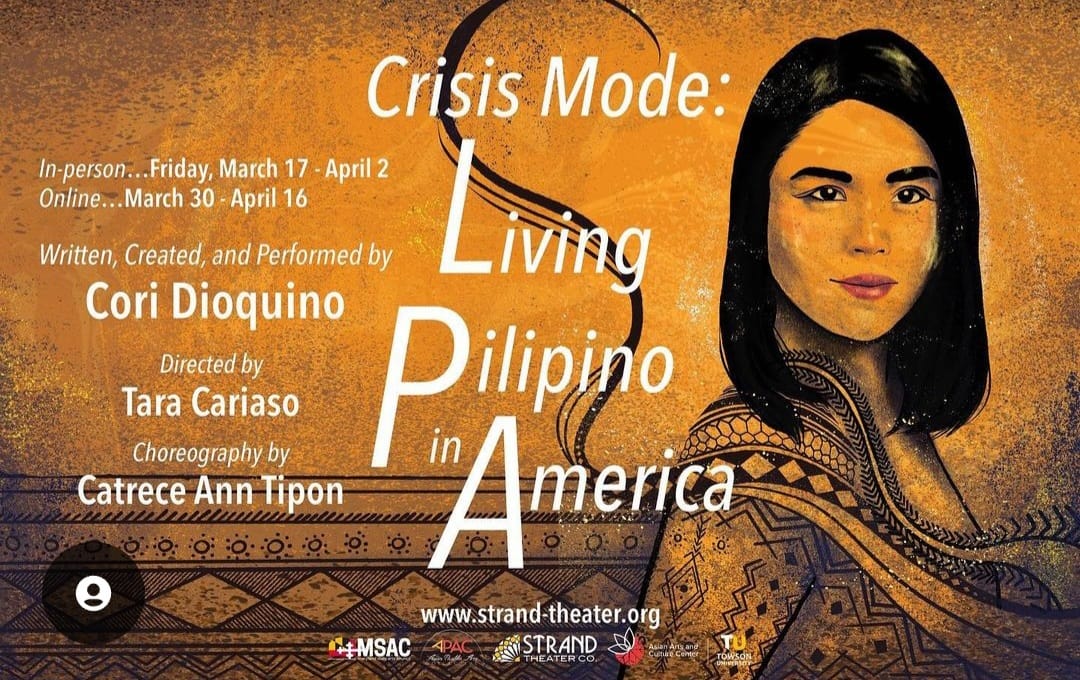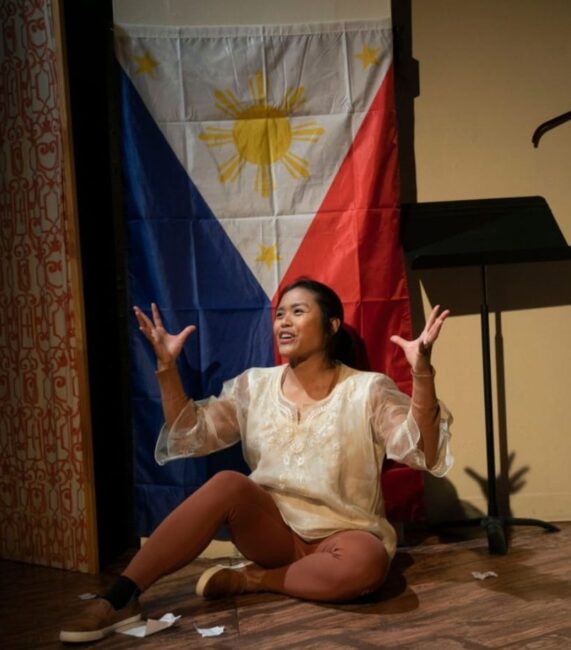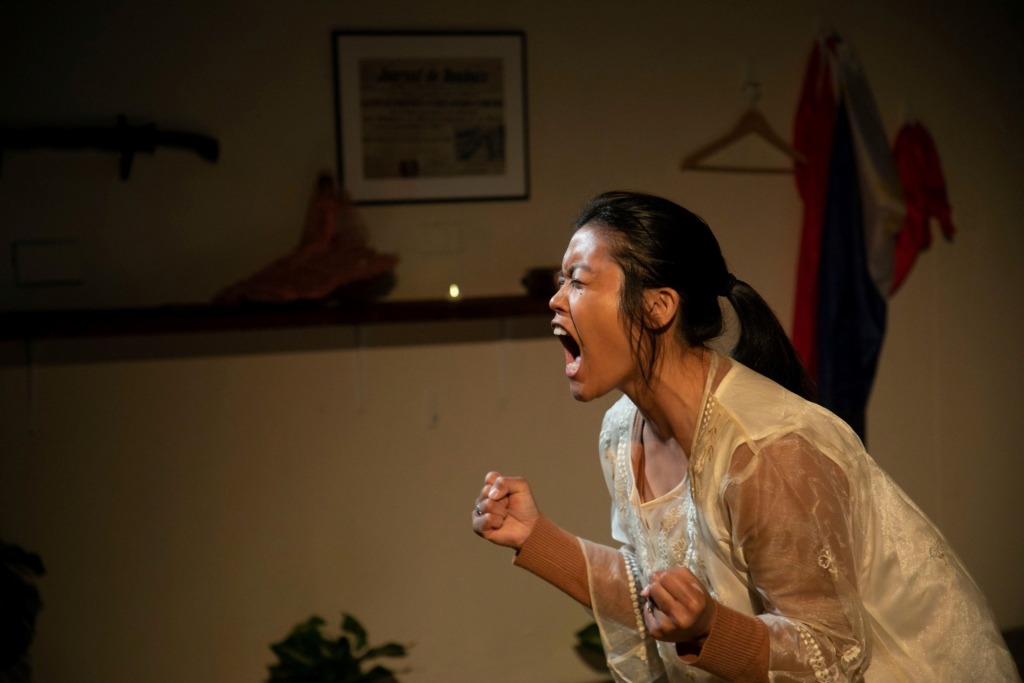Crisis Mode: Living Pilipino in America at the Strand Theater
“If every Filipino lit a candle at the same time, we would light up the world”
The popular American narrative is one based around how this nation was built on people immigrating to these shores from a variety of other lands in search of work, opportunity, or security (whether by choice or by force). Additionally, the brutal historic reality is that this narrative has always been carefully focused on specific populations at specific points in time, and this has meant there are a lot of historical context and personal accounts that have been left out of the narrative all together. It is for this reason why stories like Cori Dioquino’s Crisis Mode: Living Pilipino in America are so important. Yes, her story is different from the contemporary ones we hear about from those coming from countries so popular in the mainstream news like Mexico, or El Savador, or Cuba; but the reality is that her story shares so many similarities with those who come to the United States, whatever their reasons, and the harsh truths of how painful and traumatizing the process can be.

Before I continue, I should mention there is a content warning for this production as well as a recommendation that this production is not for audience members under the age of 13. During the course of the show there are discussions of mental illness, family separation and separation anxiety, childhood trauma, as well as brief displays and descriptions of torture, war, and death in the context of the long colonial history of the Philippines. But that being said, I highly recommend seeing this production to anyone, especially those who are open to expanding their exposure to immigration experiences and to educate themselves on the real immigration experience, and to those who would be open to exposing themselves to personal experiences that may be similar, or different, from their own experiences of immigration or identity.
Created and performed by Cori Dioquino with direction by Tara Cariaso and choreography by Catrece Ann Tipon, Crisis Mode: Living Pilipino in America takes a personal look into not only how the immigration experience has affected Dioquino through anecdotes, cultural dance and movement, and historical lessons, but also provides a personal take on how the cultural pressure to assimilate to American culture can also affect personal identity. Throughout Dioquino’s shared journey, she takes the audience through the three major identity crisis milestones she has experienced in her life (so far). From childhood and the pride of learning of Lapulapu (the man, not just the fish!), to becoming a US citizen, to making a personal pilgrimage to connect to her cultural homeland, Dioquino uses pride, humor, and frankness to take the audience through her life experiences as she questioned what it means to be herself in a world with so many different labels.
From the moments before the performance even begins, the audience is immersed in an environment that feels like being welcomed into someone’s home. The set, also designed by Cariaso, creates an intimate living space which is carefully filled with meaningful pieces of Dioquino’s personal life. Family photographs and books of her own education, as well as Filipino cultural heritage mementos like traditional clothing pieces, Tinikling sticks, and weapons adorn the stage alongside framed newspaper clippings of historic events. A strong sense of cultural pride, the traditional Filipino Sun centers the room and serves as the heart of the space.

There are a lot of very powerful moments that are able to take center stage throughout the production. Some intimate, some raw, some dynamic, some humorous, some joyful, and some somber, Dioquino will take the audience on an emotional rollercoaster as she ruminates and educates. Speaking of education, Dioquino’s experience as an arts integration educator also takes moments to shine under the spotlight as she takes moments to step into her “teacher” persona and guide the audience through historical and cultural lessons to not only provide context to her overarching themes, but also directly bring the audience into her experience through brief moments of (voluntary) audience interactions. But keep in mind, if you volunteer to participate, you may be rewarded with delicious Filipino candy!
Other highlights include Dioquino’s incorporation of a recorded interaction with her grandfather as she asks for his shared anecdotes of family experiences and involvement during the horrific period of Japanese occupation during WWII. While only one of many horrible periods in the Philippines’ long history of shifting colonial occupations, the inclusion of this segment is especially invaluable as the population alive during this time 80 years ago continues to age and take their own stories with them to whatever lies beyond. In this sense, Dioquino not only includes the audience into a very intimate conversation with her personal family as she learns about her family’s experience during this time, she (and her Grandfather) share a very powerful segment of historical context that would otherwise be lost to the annals of history.
Ever inclusive, Dioquino frequently and effortlessly glides into speaking Tagalog during several segments throughout. But don’t feel discouraged if you do not speak Tagalog fluently. While Dioquino has included visual subtitles via a projector to help those who want to understand every word she says, she also speaks with enough natural emotion and sincerity so that many can understand the general sense of what she is saying, even without the subtitles.

But that being said, my only critique of this piece has much more to do with a related lighting error than any aspect of the performance. As mentioned, during the show a projector is used frequently as a visual medium to both display visual photographs or historical political drawings to reinforce the discussion on stage, and as a translator to show subtitles for those in the audience who do not speak Tagalog. However, there were times when the lights on stage were just slightly too bright to read the text or adequately see the images from the projector. This was too bad, because there are some very compelling and striking pieces chosen for display, and their impact was diminished by being washed out.
Nevertheless, Dioquino will never fail to grasp your attention and guide you through her story. The intimacy and straightforward candor she shares with the audience makes this an important piece for others to see for a multitude of reasons. For those that have also experienced identity crisis as a result of colonialism, there is a sense of catharsis in shared similar differences. For those with limited exposure to immigrant stories, stories like these expose the brutal truth that even immigrating through legal means still causes trauma and heartache. Dioquino also addresses a very sensitive aspect and reminder of the immigration journey: that each story is unique and worthy of the acknowledgement of such. Additionally, that it is unfair for others to lump every immigrant together under the same homogeneous group and wave off their experiences because “they chose” to come to America or discount their pain because of how “lucky” they are to now be “here” instead of “there.” Dioquino’s production is a powerful reminder, or lesson to some listening for the first time: immigration is not always a happy story and all too often immigration tears families apart.
Identity is a personal journey fraught with countless factors along the way that prevent it from being a direct path. It takes a lot of courage and tenacity to share one’s personal experience along their journey, even when it is still in progress. I am not sure there are enough words to really bring home just how invaluable and important narratives like Dioquino’s are to share with the world, and with the American narrative especially. Unique to the expanding theatrical experiences of the 21st century, you can catch Dioquino’s Crisis Mode: Living Pilipino in America in-person at the Strand Theater in Baltimore now through April 2nd, or virtually online March 30th through April 16th. Although, if I were to recommend the best way to experience Dioquino’s story, I highly, highly recommend making your own journey to the Strand Theater see this production in person! Not just because of the delicious candy, but because Dioquino’s story is one that is best experienced face to face. She will speak to your heart and you will feel the power in her pride of Living Pilipino in America.
Running Time: Approximately 70 minutes without intermission.
Crisis Mode: Living Pilipino in America plays in-person through April 2nd at the Strand Theater, 5426 Harford Rd. Baltimore MD 21214, with additional online performances on March 30th thru April 16th. For tickets call the box office at (443) 874-4917 or purchase them online.

